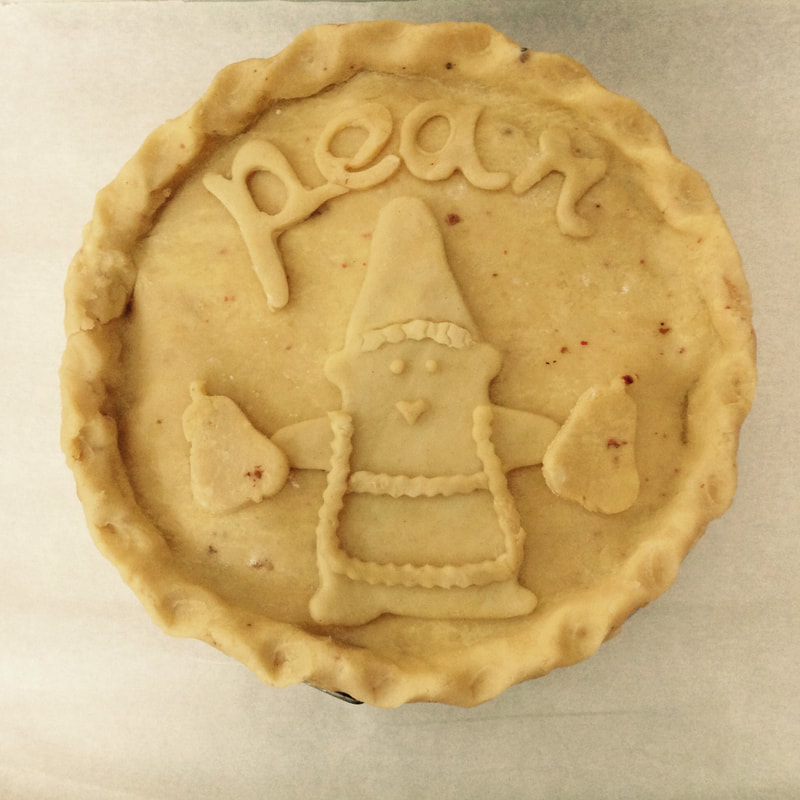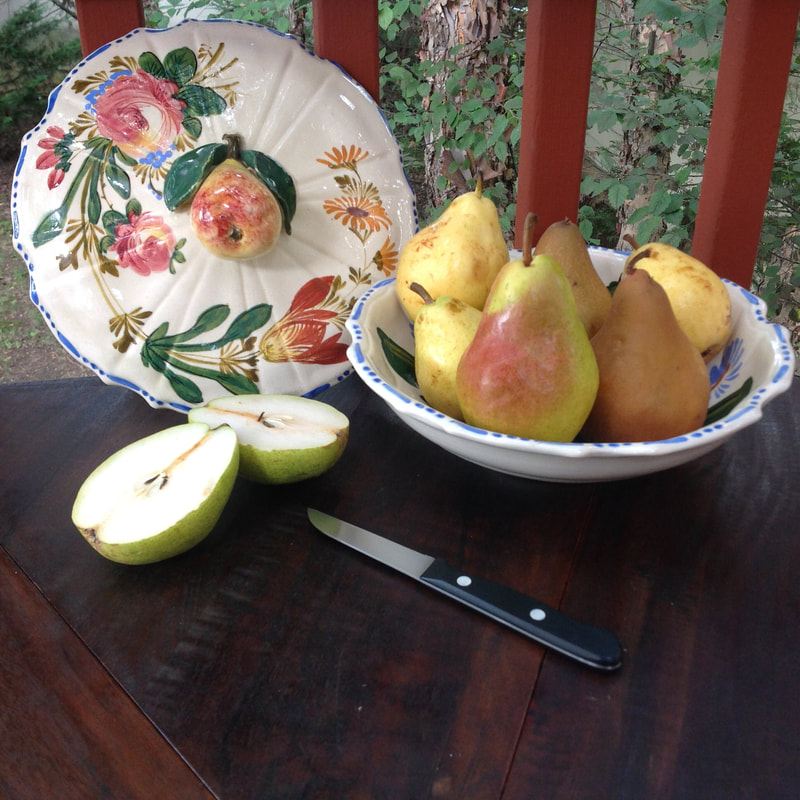|
The ample supply of Gingergold and Honeycrisp apples stacked neatly in the walk-in refrigerator have been depleted, forcing me to cross the linoleum from kitchen to dining room where we have created a makeshift fruit ‘annex.’ Heavy wooden crates filled with apples are stacked a mere whisper away from customers intent on caffeine, conversation, and free wifi. Armed with a commercial mixing bowl that should require a license to operate, I edge in towards the produce on a slight diagonal. Cutting the corner a little too closely, the lip of the mixing bowl grazes a leather shoulder strap draped across the back of a chair. Gesturing towards the fruit with my elbow, I apologize to the women sipping lattes out of Fiestaware mugs. . “Excuse me, I’m just trying to get in there…”
“Oh,” Leather Shoulder Strap looks up, slightly surprised. “You’re trying to get to the fruit? To the apples? I thought they were for sale.” “No,” I shake my head. “They’re not for sale. They’re for baking. Pies and scones, sometimes coffeecakes…” My voice trails off, muffled inside the cavernous stainless steel vessel. Realizing that the fruit is no longer a retail commodity but a wholesale ingredient, Shoulder Strap is intrigued. “Apple pies? You’re making apple pies?” I continue emptying one crate of apples, assuming my actions are self-explanatory. Shoulder Strap’s mug mate joins in on the conversation. “I’m really more of a pear person,” she confesses. “I love pears.” At the next table, a man typing furiously on his laptop is oblivious to the tight confines of fruit and baker. He continues penning his great American novel, refusing to inch his chair ever so slightly to the right. It’s a stand-off: Apple vs. apples. Shoulder Strap senses my plight and moves her vintage wooden chair ever so slightly to the left, allowing me to bob and weave. “No, I’m not crazy about pears. I’m an apple girl, myself,” Shoulder Strap, insists, draining the last of her latte. Cautiously maneuvering my unwieldy cargo away from the Kaffeeklatsch, I retreat back to the kitchen where a lethal fruit peeler awaits my return. Dodging the sharp blade of the Kuhn peeler, I consider the neediness of pears as opposed to the agreeability of apples. Personally, the sweet tartness of a Macoun or the spiciness of a Winesap conjure autumn more than anything pumpkin spice. But the pear, the perfectly ripe Anjou or Bosc or Comice, the adorably instagram-able Seckel, taunts with a season as limited as a Halloween pop-up shop. Preferring to wear their sweetness not on their sleeves, but at their core, pears ripen and sweeten from the inside out. Other than the Bartlett, pears refuse to change color offering little clue as to what degree of ripeness you will find within. Pears require the patience of a saint, imploring you to sequester them in brown paper bags, insisting you visit them often, applying just enough but not too much gentle pressure to their stem ends, hoping to catch them right before they reach the rapid downward spiral from ripe to past their prime. Pedestrian supermarket pears can be terribly difficult to read, individually swaddled in Bartlett-green tissue paper, offering no indication whatsoever as to what you will find when you take them home. The English have coined the phrase, “sleepy pear” stemming from the suggestion that one stay up all night to eat a pear in order to enjoy its fleeting moment of perfection. “Sleepy pears” refer to pears that are overripe, no doubt hidden under cases of apples, or left to ripen in a Trader Joes bag, forgotten beneath a butcher-block worktable. Two cases of pears were delivered to the bakery last week, greeted by a sleep-deprived baker. My paring knife struggled against an unripe piece of fruit, finally yielding a pear neither sweet nor ripe, taunting with the promise of lattice tops and cardamom spice. Outwardly, it was the perfect shade of chartreuse, its stem cocked at just the right angle. Inwardly, the flavor was somewhat reminiscent of wax fruit. Not any old wax fruit; the kind once artfully arranged in an ornate bowl gracing a dining room table in the furniture department of Bloomingdale’s. Under my watchful eye, the pears refused to ripen for days, until one morning I noticed the slightest fragrance hovering above the crates. Teetering on the brink of “sleepy,” the fruit required immediate attention. I rinsed, peeled, cored, and sliced with abandon. The pears were ambrosial but devilishly slippery, skidding off the cutting board, taking a nose-dive, landing on the petri dish of a floor. The ones that survived were tucked into pie shells, layered into the Cake-Formerly-Known-As-Apple, tossed with flour, butter, and buttermilk for scones. I couldn’t use them fast enough and in the end, some of them had indeed fallen into a deep-past-their-pear-prime slumber. The entire process was both nerve wracking and exhilarating without involving the slightest pinch of spices reserved for that orange gourd. On the home front, a brown paper bag harboring four pounds of pears offered no indication of ripeness. They were just as I had left them days before, neither yielding to pressure at their stem ends, nor offering the slightest hint of perfume. Running out of patience and with a few hours on my hands, I decided it was time to rouse the pears, sweeten them with brown sugar and Amaretto, and splash them with citrus. The fruit sneezed under a few pinches of pink pepper and a generous hit of cardamom before filling an 8" springform pan. And while the pie baked for over an hour, I did what any baker does; filled my favorite over-sized mug with caffeine and pored over cookbooks, staving off sleep. From the dining room table, my grandmother’s Capodimonte fruit bowl filled with Bosc, Bartlett, and Anjou winked in approval.
0 Comments
Leave a Reply. |
Archives
July 2024
Ellen GrayProfessional Pie-isms & Seasonal Sarcasm Categories |


 RSS Feed
RSS Feed